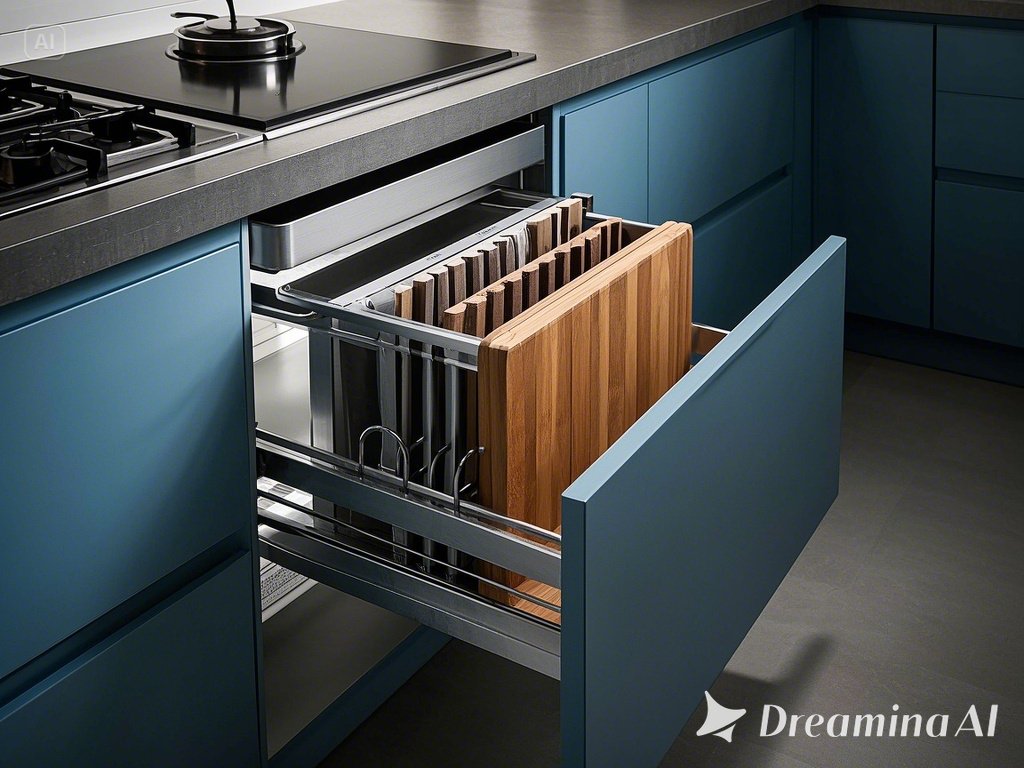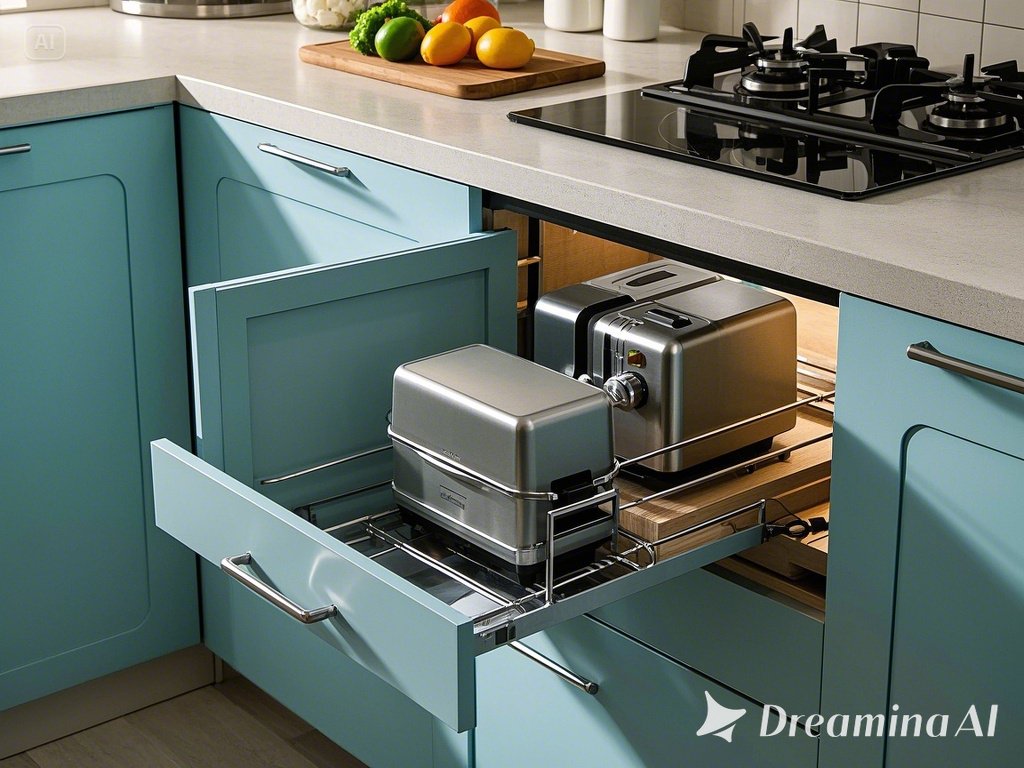Revitalizing your kitchen doesn’t always require a full-scale renovation. Sometimes, the most impactful changes come from clever storage solutions that blend functionality with personal style. DIY kitchen shelving projects offer a fantastic way to achieve this, allowing you to customize your space, display treasured items, and keep essentials within easy reach. Whether you’re working with a sprawling country kitchen or a compact urban apartment, there’s a DIY shelving idea to suit your needs and aesthetic preferences. These projects range from simple weekend builds to more intricate designs, empowering you to add character and efficiency to the heart of your home. Exploring different materials, finishes, and configurations can unlock hidden potential in your kitchen layout, reflecting current design trends seen across the US and Europe while catering perfectly to your individual taste and organizational requirements. Get ready to be inspired by these diverse approaches to kitchen shelving.
Rustic Farmhouse Charm with Reclaimed Wood

Embracing the rustic farmhouse aesthetic remains a popular choice for kitchen design in both the US and increasingly in European homes seeking warmth and character. DIY shelves crafted from reclaimed wood are the cornerstone of this style. Think weathered barn wood, salvaged planks, or even old pallet wood, each piece telling a story with its unique grain, knots, and imperfections. The beauty lies in this authenticity. For colors, stick to natural wood tones, perhaps enhanced with a clear matte sealant to protect against kitchen moisture without adding unnatural shine. Alternatively, a distressed white or cream paint finish achieves that classic farmhouse look, especially when paired with darker wood countertops or island tops. Consider combining these shelves with robust, visible brackets, often in matte black cast iron or antiqued brass, adding an industrial counterpoint that prevents the look from becoming overly quaint. Styling these shelves involves curated clutter: display vintage stoneware pitchers, mason jars filled with dry goods (flour, sugar, pasta), enamelware, antique scales, and perhaps a few trailing plants like pothos in terracotta pots. The trend leans towards authenticity, so avoid overly perfect finishes. In the EU, particularly in France and the UK, integrating these rustic shelves with more contemporary elements like sleek cabinetry or metro tiles creates a sophisticated juxtaposition, often termed ‘modern farmhouse’. Keep the arrangement practical – everyday dishes, mugs, and frequently used spices should be easily accessible, blending the decorative with the functional.
Minimalist Floating Shelves for Sleek Lines
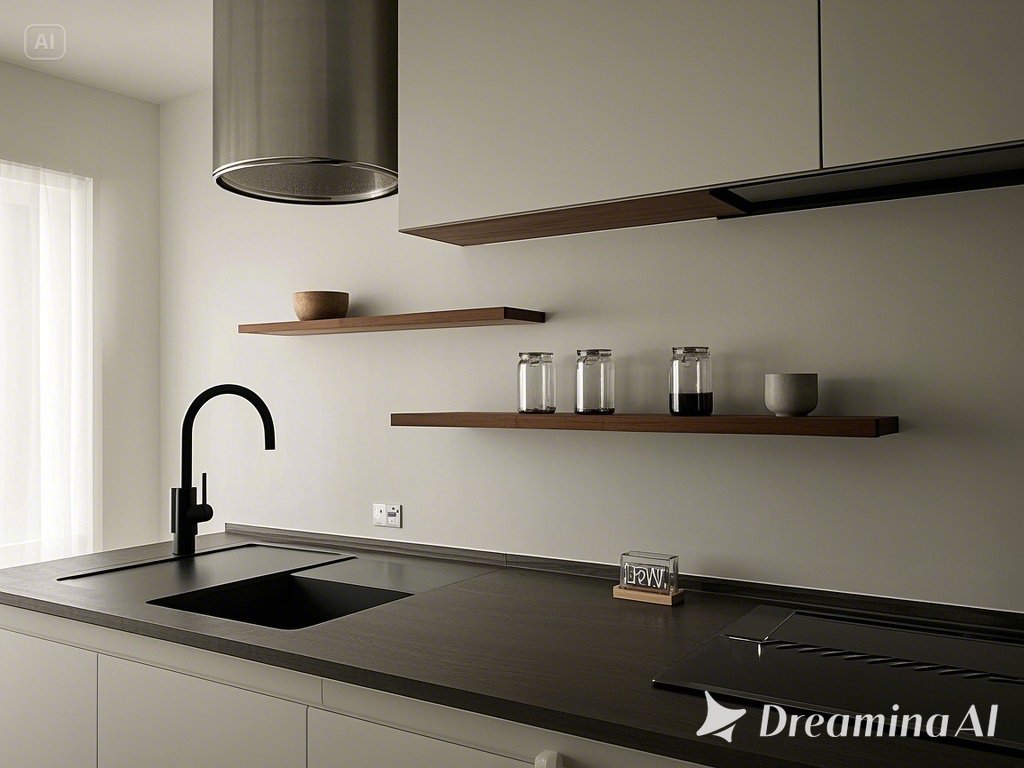
Minimalism continues its reign in contemporary kitchen design, particularly favored in urban dwellings across the US and Northern Europe where space is often at a premium. DIY floating shelves are the epitome of this style, offering clean lines and an uncluttered appearance. The magic lies in the hidden hardware – specialized brackets that mount directly to the wall studs and are concealed entirely within or beneath the shelf plank. This creates the illusion that the shelf is simply emerging from the wall. Material choices often include smooth, high-quality MDF painted to match the wall color for ultimate camouflage, or sleek, light-grained woods like maple, birch, or ash with a natural or light whitewash finish. Color palettes are typically neutral: crisp white, soft grey, deep charcoal, or even black for a dramatic statement. The key is simplicity and lack of ornamentation. These shelves work exceptionally well against a simple backsplash, like large-format tiles or a solid slab of quartz. Styling should be sparse and intentional. Arrange a few carefully chosen items – identical white ceramic bowls, a single piece of sculptural pottery, minimalist glassware, or a small, architecturally interesting plant like a succulent in a geometric pot. Avoid overcrowding at all costs. The trend emphasizes quality over quantity. In Scandinavian design, a major influence here, these shelves often hold functional items but arranged with artistic precision. The DIY aspect involves precise measurement and secure mounting to wall studs to support the weight, making it a project requiring care but achievable for most DIYers.
Industrial Chic with Pipes and Planks

The industrial aesthetic, born from converted warehouses and lofts in cities like New York and London, brings a raw, edgy vibe to kitchen spaces. DIY pipe shelving is a hallmark of this style and surprisingly straightforward to construct. Using standard plumbing pipes and fittings (like elbows, tees, flanges, and nipples) available at any hardware store, you can create a custom framework. The pipes are typically finished in matte black, dark grey, gunmetal, or even left with their natural metallic sheen, sometimes lightly sealed to prevent rust. These are paired with sturdy wood planks – chunky pine, stained dark walnut or ebony, or even reclaimed wood for added texture. The contrast between the cool metal and the warm wood is central to the look. Color combinations often involve these dark metals and woods set against exposed brick walls, concrete surfaces, or simple white subway tiles. Styling leans towards functional and slightly utilitarian: display heavy-duty cookware, cast iron pans, metal canisters, whiskey glasses, and perhaps some Edison bulb pendant lights hanging nearby to reinforce the theme. Plants in metal or concrete pots add a touch of organic softness. This style remains popular in the US and is gaining traction in European urban centers, often integrated into modern kitchens to add character. The DIY element involves cleaning and potentially painting the pipes, cutting and finishing the wood planks, and assembling the structure securely to the wall using flanges.
Scandinavian Simplicity: Light Wood and White
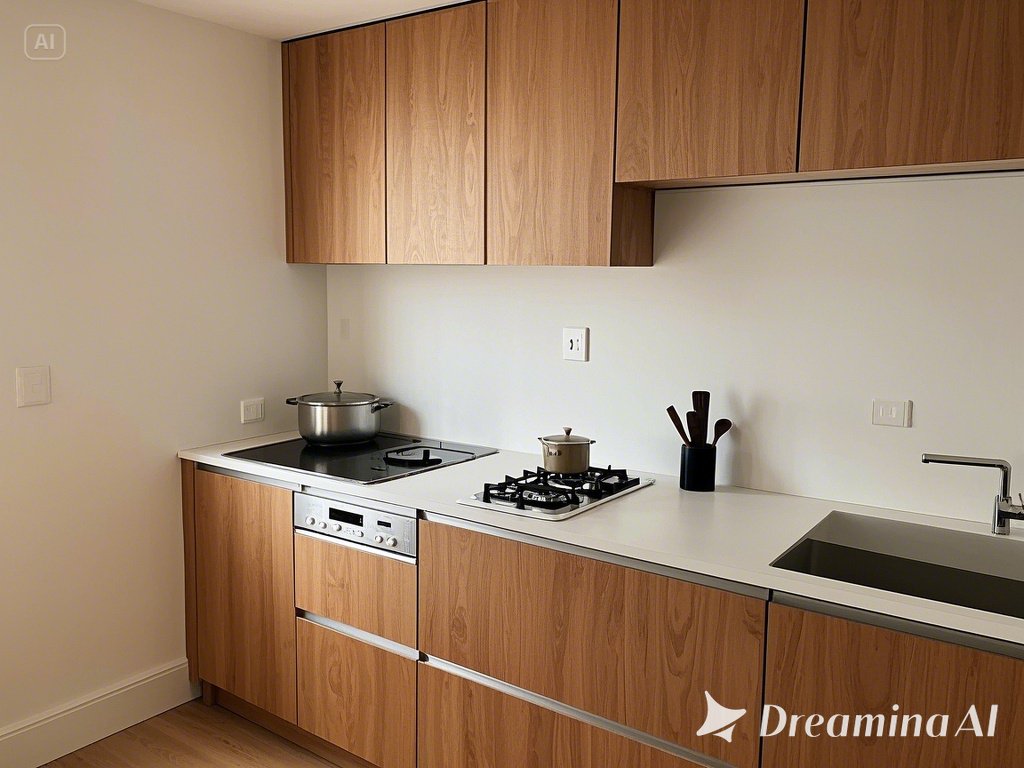
Scandinavian design principles of simplicity, functionality, and connection to nature translate beautifully into kitchen shelving. Think light, airy, and uncluttered. DIY shelves in this style often feature light-toned woods such as birch, ash, pine, or light oak, either left natural or treated with a subtle whitewash or clear matte finish. The shelf design itself is typically simple – straight planks, perhaps with slightly rounded edges, supported by minimalist brackets (often white or brushed metal) or configured as floating shelves. The quintessential Scandi color palette revolves around white walls, light wood tones, and accents of soft grey, pale blue, or muted green. The shelving should integrate seamlessly into this calm environment. Functionality is key; these shelves are meant to be used. Arrange everyday ceramics (often in white or neutral stoneware), simple glassware, small potted herbs like basil or mint, and perhaps a few aesthetically pleasing cooking oils or spice jars. The emphasis is on natural textures and materials. Avoid clutter; embrace negative space. This style is enduringly popular across Northern Europe and widely adopted in the US for its clean, bright, and hygge-evoking feel. A current trend is incorporating subtle curves or organic shapes into the shelf design or brackets, softening the minimalism. DIY projects can range from simple plank-and-bracket setups to more integrated systems, always focusing on clean craftsmanship and natural materials.
Bohemian Flair with Rattan and Macramé
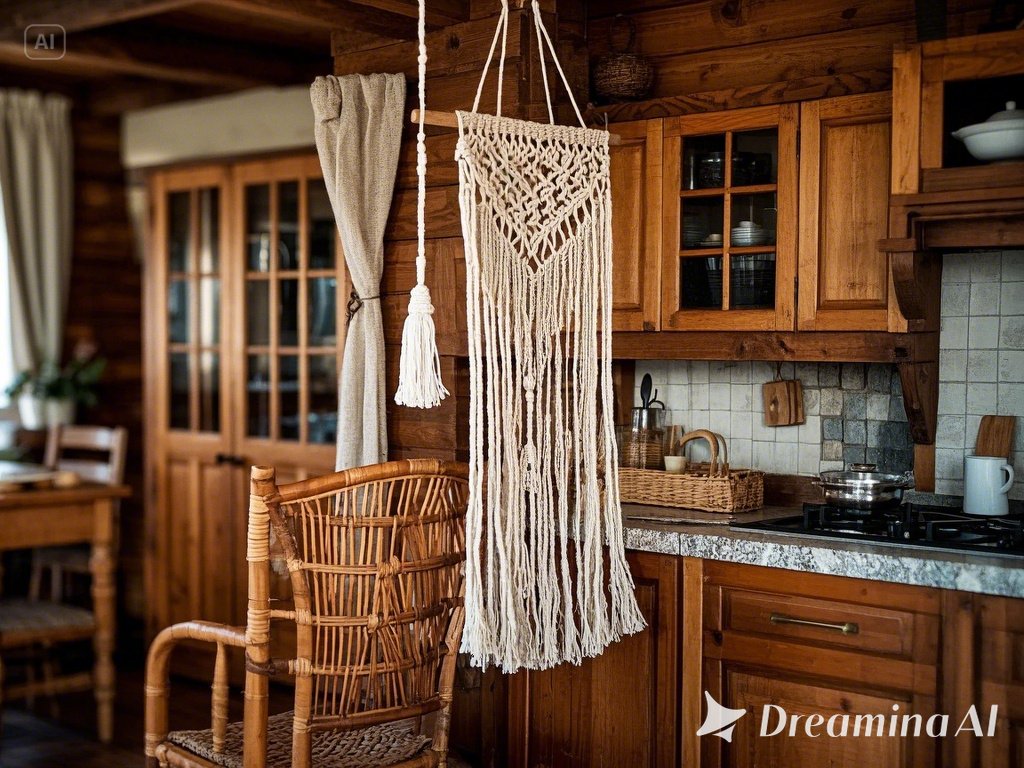
For a more relaxed, eclectic, and free-spirited kitchen vibe, Bohemian-inspired shelving offers a wealth of DIY possibilities. This style celebrates natural materials, textures, and handcrafted elements. Shelves might be simple wooden planks suspended by macramé hangers knotted from natural cotton rope – a very accessible DIY project. Another option involves using woven materials like rattan or cane, either as the shelf surface itself (for lighter items) or as decorative backing or edging for wooden shelves. Color palettes are warm and earthy: natural wood tones, terracotta, mustard yellow, olive green, and creamy whites, often mixed with vibrant patterns on nearby textiles or ceramics. The shelves themselves might be stained a medium wood tone or painted a soft, muted color. Styling is maximalist yet curated. Display handmade pottery with irregular glazes, colorful glassware, an abundance of trailing plants (like string of pearls or ivy), collected trinkets, and cookbooks with artistic covers. Layering textures is key – think woven baskets, ceramic planters, and wooden utensils. This look is popular in the US, particularly California, and resonates with European homeowners seeking personalized, less formal interiors. Sustainability is often a core tenet, favoring vintage finds and natural, renewable materials like bamboo or rattan. DIY projects often involve knotting, weaving, or combining found objects, allowing for significant creative expression.
Mid-Century Modern Angled Shelving
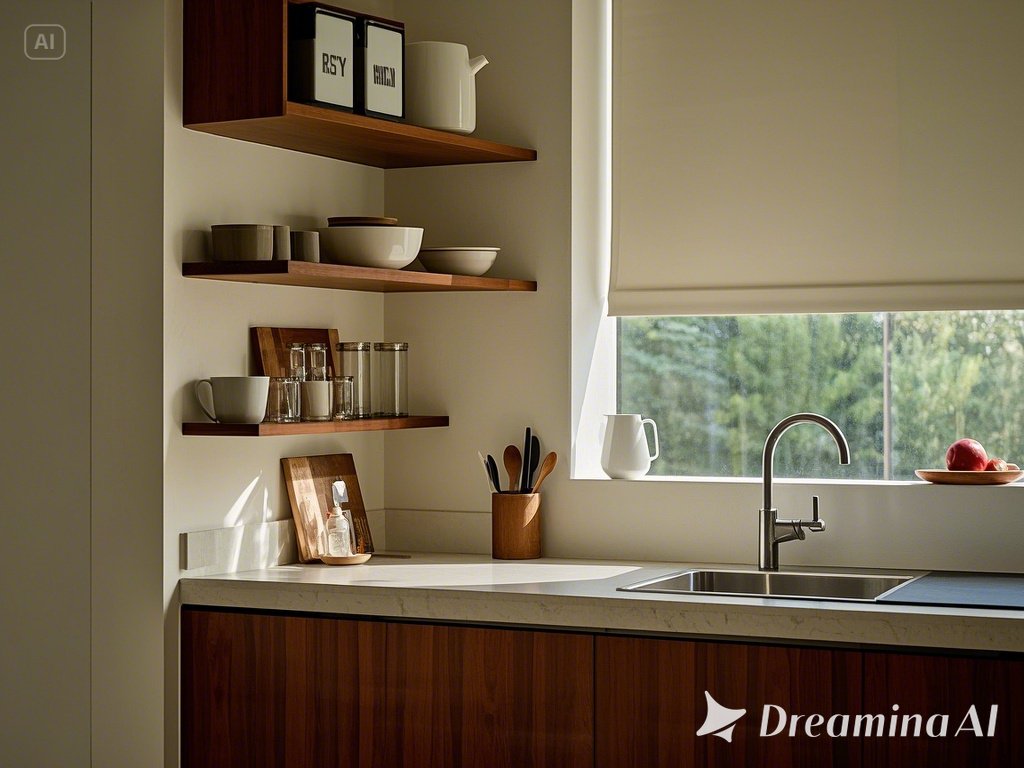
Mid-Century Modern (MCM) design, originating from the mid-20th century, continues to influence contemporary interiors with its clean lines, organic shapes, and emphasis on functionality. DIY kitchen shelves in this style often feature distinctive angled brackets or asymmetrical arrangements. Materials typically include warm woods like teak, walnut, or stained oak, often with a smooth, semi-gloss finish. Metal accents, particularly brass or black powder-coated steel, are common for brackets or detailing. Floating shelves are also appropriate, but often with a slightly thicker profile or a subtle bevelled edge. A hallmark of MCM shelving can be integrated, non-traditional shapes – think parallelogram-shaped shelf units or shelves with lipped edges. Color combinations pair these warm wood tones with classic MCM accent colors like avocado green, burnt orange, mustard yellow, teal, or muted blues, often set against a backdrop of white or neutral walls. Geometric patterns on backsplashes or textiles can complement the look. Styling should be curated and somewhat retro: display period-appropriate ceramics (like Russel Wright or Eva Zeisel designs if you can find them!), minimalist glassware, cocktail accoutrements, and perhaps a starburst clock nearby. Keep arrangements balanced but not strictly symmetrical. This style has seen a huge resurgence in both the US and Europe, appreciated for its timeless elegance and ergonomic focus. DIY projects might involve more precise woodworking to achieve specific angles or finishes, but the results are sophisticated and enduring.
Coastal Vibes with Blue Hues and Weathered Finishes

Bring the relaxed feel of the seaside into your kitchen with coastal-inspired DIY shelving. This style evokes light, airiness, and natural elements. Simple wooden shelves, often painted in shades of blue (from soft sky blue to deep navy) or classic white, are key. A weathered or distressed finish can enhance the beachy vibe, mimicking sun-bleached or sea-worn wood. Alternatively, natural light wood like pine or driftwood, perhaps with a whitewash finish, works beautifully. Brackets can be simple white-painted wood, brushed nickel for a touch of modern coastal, or even rope supports for a nautical twist. Color palettes are dominated by blues, whites, sandy beiges, and seafoam greens, creating a fresh and calming atmosphere. Pair these shelves with a shiplap wall treatment or a simple tile backsplash in white or pale blue. Styling involves displaying beachcomber finds like shells or sea glass in jars, white or blue ceramic dishes, woven baskets for texture (reminiscent of fishing nets or dune grasses), and perhaps some glassware in sea-glass colors. Keep it light and uncluttered to maintain the airy feel. This style is perpetually popular in US coastal regions and finds favour in European seaside towns, often interpreted with local nuances (e.g., Mediterranean blue and white vs. New England navy and white). DIY is straightforward, often involving simple paint finishes or sourcing interesting pieces of driftwood.
Glamorous Metallic Accents: Brass and Glass

For a touch of sophistication and luxury, incorporate metallic accents into your DIY kitchen shelving. Brass and gold tones are particularly on-trend, adding warmth and glamour. Consider sleek metal shelving units with thin profiles, perhaps combining brass or gold-finished frames with glass or marble shelves. Alternatively, use standard wood shelves (painted in a deep jewel tone like emerald green, sapphire blue, or even black) and elevate them with striking brass or gold brackets. Floating shelves with a subtle metallic edge trim also fit this aesthetic. Glass shelves, either clear or smoked, supported by elegant metallic brackets, maximize light and create a sense of openness while adding sparkle. Color combinations often pair these metallics with rich, saturated colors or classic black and white for a chic contrast. Think marble-effect backsplashes or countertops to complement the luxurious feel. Styling should be elegant and curated: display crystal glassware, metallic-rimmed plates, high-end spirit bottles, small decorative objects, and perhaps a small vase with a single, elegant flower. This trend is prominent in both US and European contemporary design, often seen in high-end kitchens but achievable on a DIY budget with careful selection of hardware and finishes. Using metallic spray paint on existing brackets or building simple shelves with standout hardware are accessible DIY routes.
Dark and Moody Shelving Statements
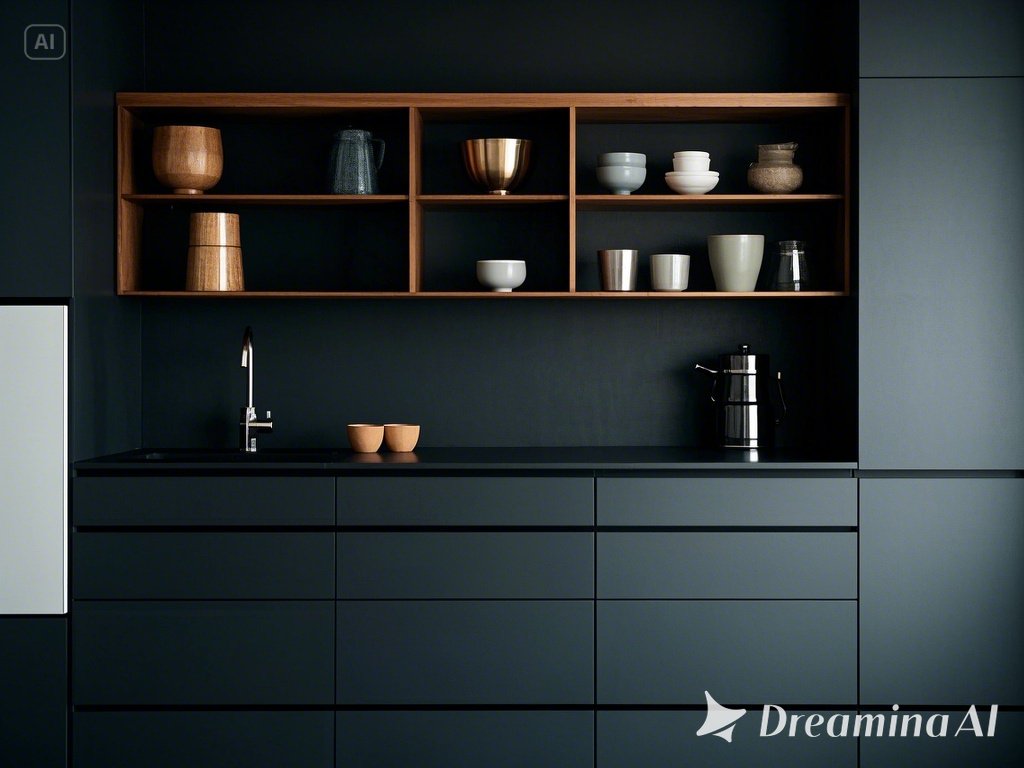
Moving away from the ubiquity of white kitchens, dark and moody aesthetics are gaining significant traction in both the US and Europe, creating intimate and sophisticated spaces. DIY shelving can play a crucial role in this style. Opt for shelves made from dark woods like walnut or ebony, or paint standard wood or MDF shelves in deep, dramatic colors such as charcoal grey, deep navy, forest green, or even matte black. The finish is often matte or satin rather than high gloss to absorb light and enhance the moody atmosphere. Consider matching the shelf color to the wall color for a seamless, enveloping effect, or use the dark shelves as a contrast against a slightly lighter but still moody wall (like a deep teal or burgundy). Brackets can be equally dark and discreet, perhaps black metal or matching the shelf color, or you could introduce a contrasting metallic like aged brass for a touch of warmth and luxury. Styling these shelves requires careful consideration of lighting. Display items that stand out against the dark background: white ceramics, metallic objects (copper or brass work well), amber glassware, and green plants. Integrated under-shelf LED lighting is highly recommended to illuminate the displayed items and prevent the area from feeling too cavernous. This look works well in kitchens with good natural light to balance the darkness, or in smaller kitchens where it can create a jewel-box effect.
Open Pantry Shelving for Functional Display
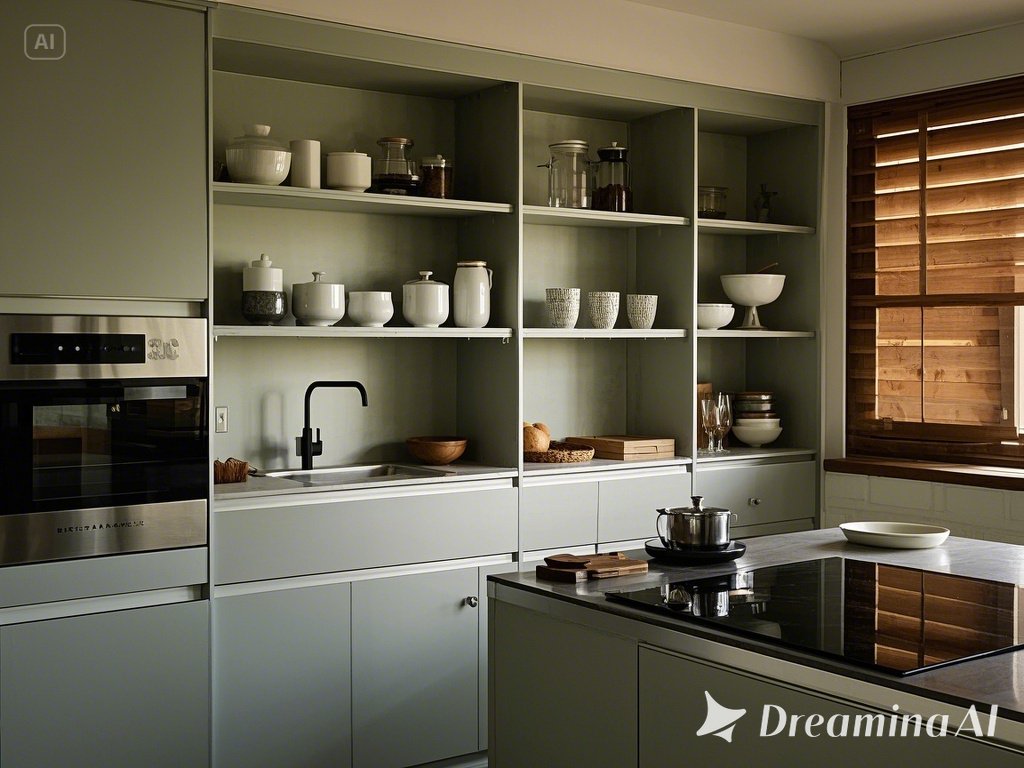
Merging storage with display, open pantry shelving transforms a functional necessity into a design feature. This is less about a specific style and more about an approach to storage, popular across various aesthetics from farmhouse to industrial to modern. DIY open pantry shelves are typically robust and practical, designed to hold heavier items like jars, canisters, mixing bowls, and small appliances. Simple, sturdy wood planks (pine, oak, or poplar) are a common choice, either stained or painted. Shelf depth might be greater than standard decorative shelves to accommodate larger items. Consider adjustable shelving systems using wall-mounted standards and brackets for flexibility. Color-wise, you can match the shelves to your cabinetry, contrast them, or match them to the wall color for a built-in look. White or light wood keeps the pantry area feeling bright and organized, while darker tones can add drama. The key is organization and curation. Use matching containers (glass jars, wire baskets, wooden crates) to corral items and create visual cohesion. Decant dry goods into labeled jars. Arrange items by category or color. While functional, the display should still be aesthetically pleasing. This trend is strong in the US, where larger kitchens often accommodate dedicated pantry areas, and is also seen in European homes, sometimes integrated into smaller alcoves or wall sections. The DIY aspect focuses on sturdy construction and thoughtful layout planning.
Clever Corner Shelf Solutions

Kitchen corners are notoriously tricky spaces, often underutilized or filled with awkward cabinets. DIY corner shelving offers a brilliant solution to reclaim this dead space, turning it into functional and attractive storage or display. Designs can vary widely. Simple triangular or quadrant-shaped shelves fitted directly into the corner maximize space efficiently. Another popular DIY approach is wrap-around shelving, where two shelves meet at the corner, creating a continuous line. Floating corner shelves offer a minimalist look, while chunkier wooden shelves with visible brackets can suit farmhouse or industrial styles. Materials can range from wood (painted or stained) to glass (for a lighter feel) or even metal. Color choices depend on the overall kitchen aesthetic – matching the walls blends them in, while contrasting colors make them a feature. Styling corner shelves requires thinking in three dimensions. They are ideal for displaying decorative items like vases, plants, or cookbooks, or for storing frequently used items like mugs, spices, or oils. Consider adding small LED puck lights underneath to illuminate the corner. This practical solution is universally appreciated, addressing a common kitchen layout challenge in both US and EU homes. DIY difficulty ranges from simple cuts for basic triangular shelves to more complex joinery for wrap-around designs.
Under-Cabinet Nooks and Mini-Shelves
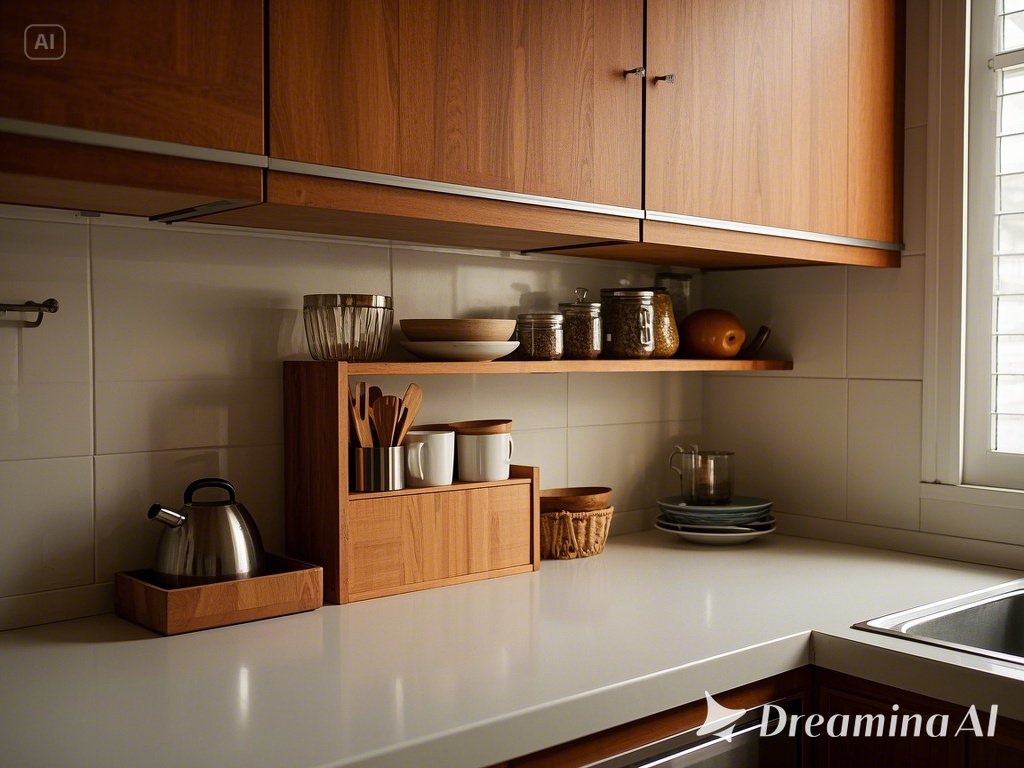
Maximize every inch of kitchen space by incorporating small DIY shelves or nooks beneath upper cabinets. This often-overlooked area is perfect for keeping frequently used items handy or adding small decorative touches without cluttering the countertop. A simple, narrow shelf installed just below the upper cabinet can hold spice jars, small oil bottles, or a salt cellar. You could also build a small cubby or box-like structure. Materials should be relatively thin and light – thin wood, painted MDF, or even acrylic. Color matching to the underside of the cabinet or the backsplash creates a subtle, integrated look. Alternatively, a contrasting material like a thin slab of marble, quartz offcut, or a warm wood tone can add a point of interest. These mini-shelves are ideal for task-specific storage – a small shelf near the coffee maker for sugar and stirrers, or one near the stove for essential spices and cooking oils. They can also host small decorative elements like tiny succulents or a framed postcard. This micro-storage trend is particularly relevant in smaller kitchens, common in many European cities and US apartments, where optimizing space is paramount. The DIY aspect is generally simple, requiring basic cutting and mounting skills, often using small L-brackets or even strong adhesive strips for very light loads.
Pegboard Versatility for Walls and Backsplashes
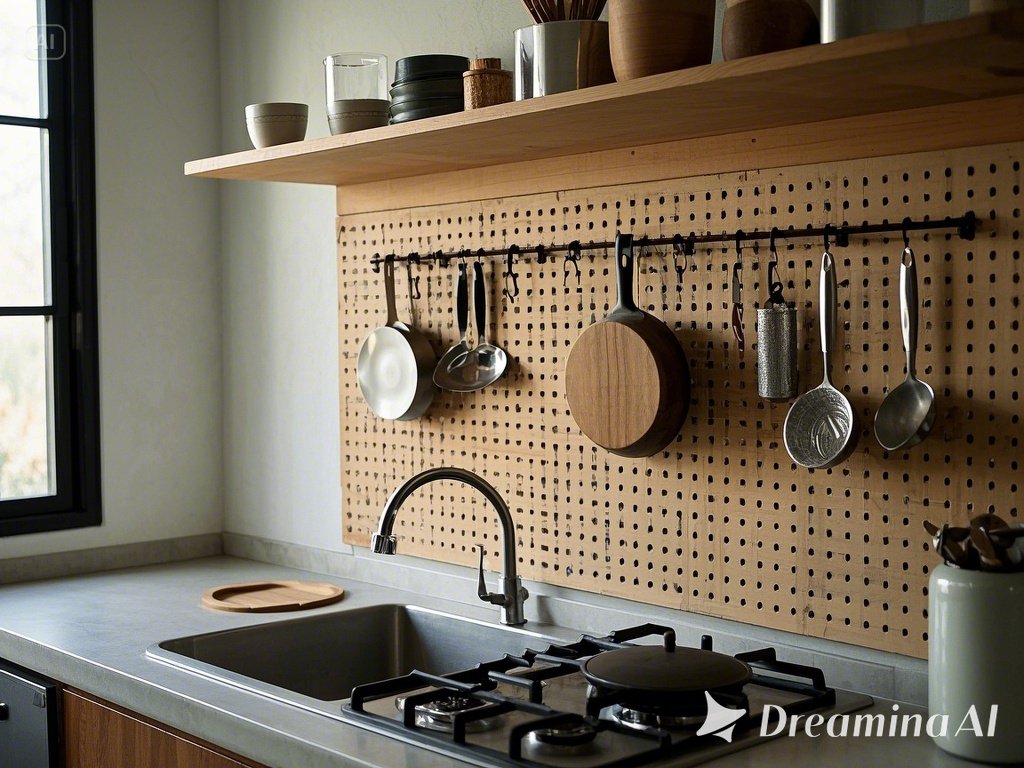
Pegboards offer unparalleled versatility and a slightly retro, utilitarian charm, making them a fantastic DIY shelving and organization solution for kitchens. Traditionally found in workshops, pegboards have migrated into stylish interiors across the US and Europe. A large pegboard panel can be mounted on a wall or even used as a backsplash section. The beauty lies in the customizable arrangement of pegs, hooks, small shelves, baskets, and holders that can be repositioned at will. You can DIY small wooden shelves that slot securely into the peg holes. Materials for the pegboard itself include standard hardboard (often painted), wood, or even metal for an industrial look. Colors can range from classic white or natural wood to bold hues that create a feature wall. Painting the pegboard to match the kitchen cabinets or walls offers a more integrated feel. Use it to hang utensils, mugs, small pans, cutting boards, herb pots, and, of course, small custom-fit shelves for spices or decorative objects. The look can be adapted – natural wood pegboard for a Scandi feel, black metal for industrial, or brightly colored for a playful, modern kitchen. This solution is highly practical, keeping frequently used items visible and accessible while freeing up counter space. It’s a relatively easy DIY project involving mounting the board securely and acquiring or making various pegs and shelf accessories.
Leather Strap Shelves for a Chic Touch
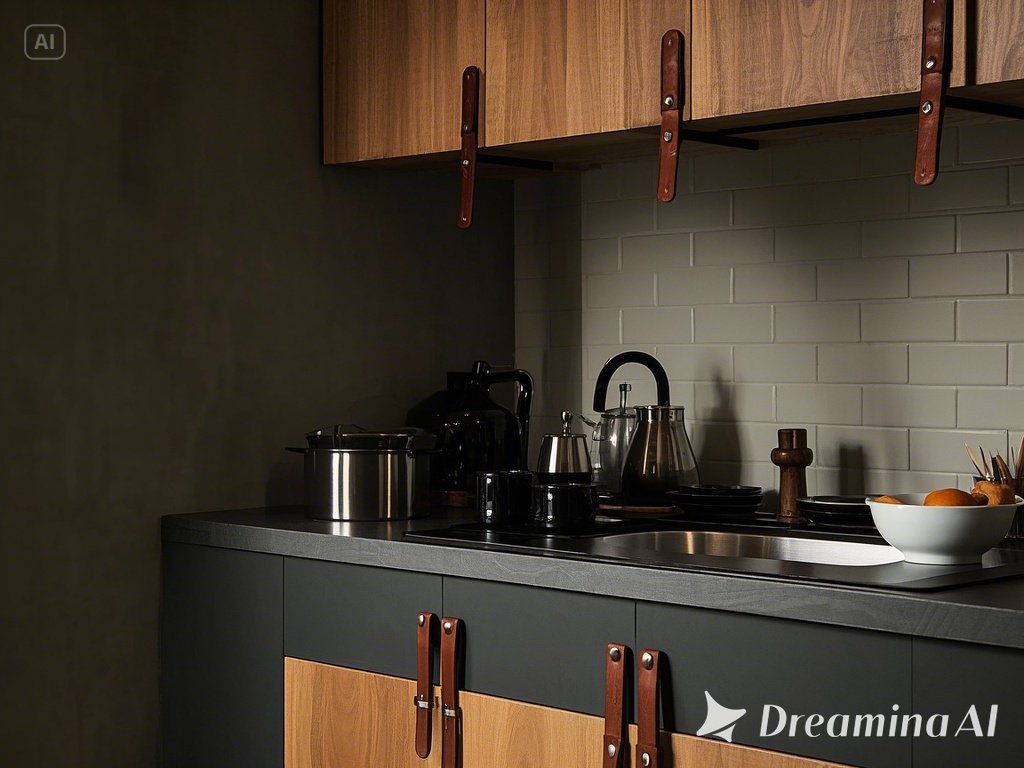
For a touch of minimalist chic with a hint of rustic or Scandinavian influence, consider DIY shelves suspended by leather straps. This design is elegantly simple yet visually striking. It typically involves a flat wooden plank (light wood like pine or ash for Scandi, darker stained wood or reclaimed wood for rustic/industrial) supported by two loops of leather straps screwed securely to the wall. The leather can be natural tan, dark brown, black, or even colored (though neutrals are more common and versatile). The width and thickness of the leather straps contribute to the overall look – wider straps for a more robust feel, thinner for delicate elegance. Brass or copper screws can add a subtle metallic accent. These shelves are best suited for lighter decorative items rather than heavy dinnerware – think small plants, framed photos, ceramic vases, or a few favourite mugs. The color combination of natural wood and leather is timeless and works well against white or neutral walls. This style has been popular in design blogs and magazines in both the US and Europe, appealing to those who appreciate handcrafted details and natural materials. The DIY aspect is straightforward: cut and finish the wood plank, cut the leather straps to size (ensuring they are identical), fold them into loops, and securely mount them to the wall, ensuring the shelf sits level within the loops.
Geometric Honeycomb Shelves
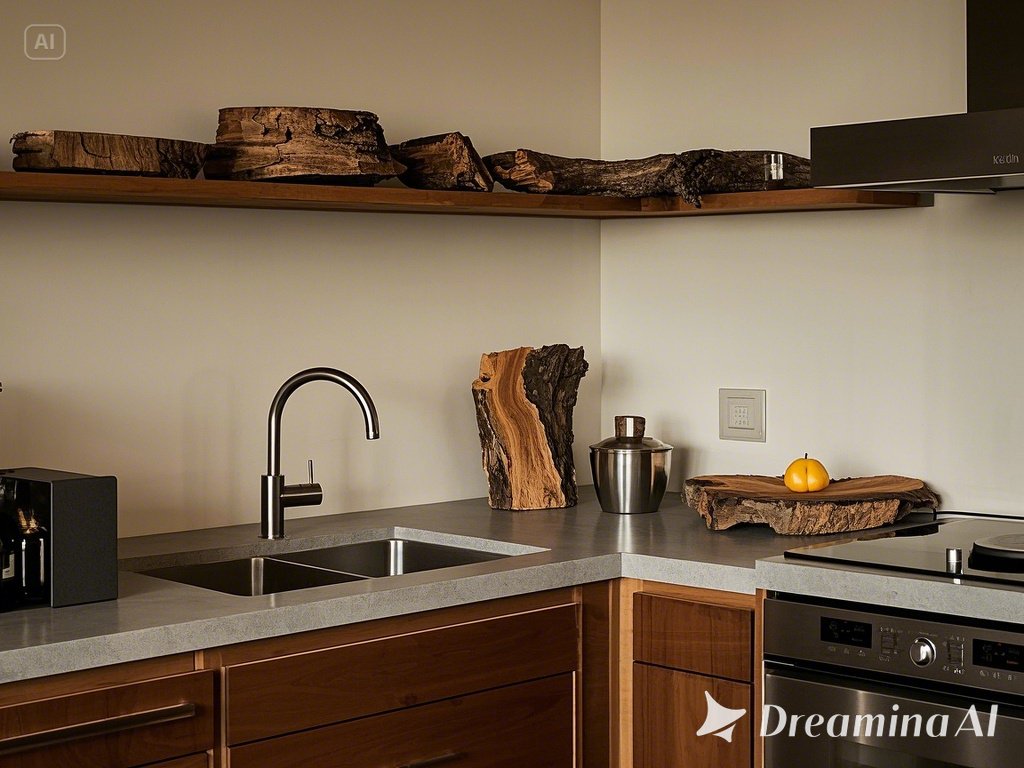
Add a playful and modern touch to your kitchen with DIY geometric honeycomb shelves. These hexagonal units can be used individually or grouped together to create interesting patterns on the wall. Made typically from wood (pine or poplar is easy to work with), each hexagon requires precise angled cuts (usually 30 degrees) to fit together perfectly. They can be left natural, stained, or painted. Painting the inside back of the hexagon a contrasting color or lining it with patterned wallpaper adds depth and personality. Color combinations can be monochrome (all white, grey, or black), feature natural wood tones, or incorporate pops of bright color (yellow, teal, coral) for a more vibrant look. Arrange them in an organic cluster or a more structured pattern. These shelves are ideal for displaying small decorative items, succulents, spice jars, or tea canisters. Their unique shape inherently draws the eye. This trend appeals to those seeking modern, slightly unconventional design elements and is popular in both US and EU contemporary interiors. While the angled cuts require precision (a miter saw is highly recommended), assembling the hexagons is relatively simple with wood glue and possibly small nails or screws. Mounting them securely to the wall, especially in a cluster, requires careful planning.
Live Edge Wood Shelves for Natural Beauty
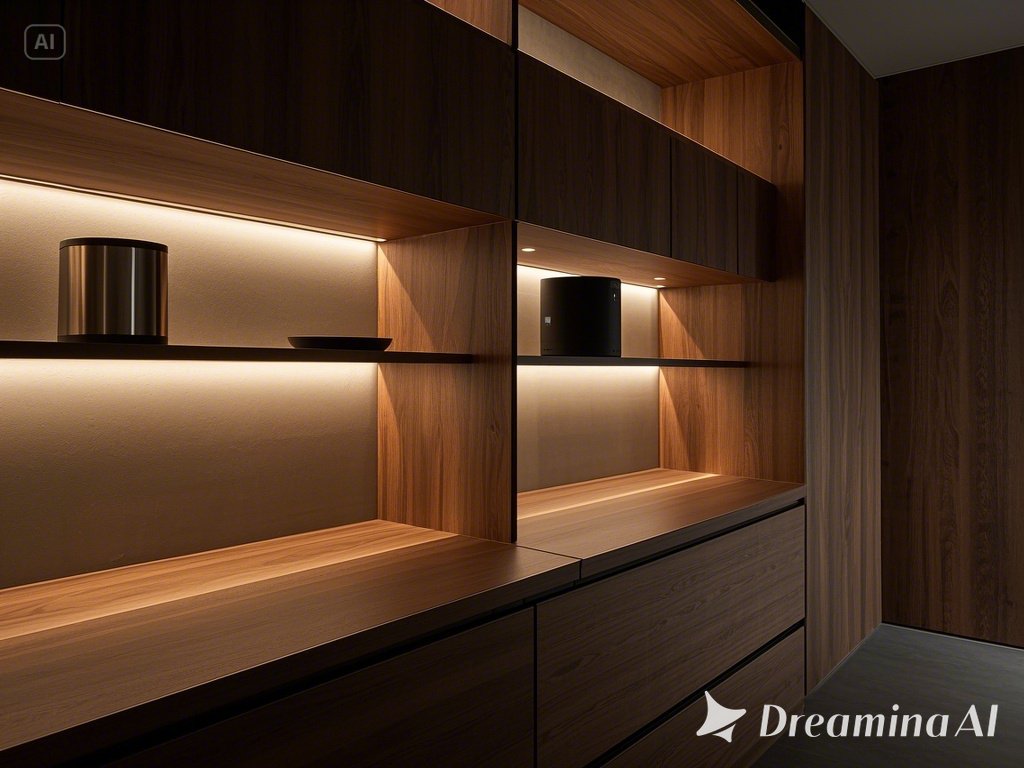
Celebrate the organic beauty of wood with DIY live edge shelves. A live edge shelf preserves the natural, uncut edge of the wood slab on one side, showcasing the tree’s original contours and bark (sometimes removed for a smoother finish). Each piece is unique, bringing a significant dose of nature and rustic elegance into the kitchen. Woods like walnut, maple, cherry, or oak with interesting grain patterns and natural edges are ideal. The wood is typically finished with a clear sealant (matte or satin) to highlight its natural beauty and protect it. These shelves make a strong statement and are often used as feature pieces rather than extensive storage. They can be mounted using hidden floating shelf hardware for a clean look that emphasizes the wood’s shape, or with minimalist black metal brackets for an industrial or modern rustic contrast. Color pairings are usually simple – let the wood be the star against a neutral wall (white, grey, beige). Styling should be minimal to avoid detracting from the shelf itself: perhaps a few pieces of artisanal pottery, a sculptural vase, or a small plant. Live edge furniture and accents are highly valued in contemporary design across the US and Europe, fitting well within biophilic design trends that seek to connect interiors with nature. Sourcing the right slab and finishing it properly are key DIY steps, along with secure mounting.
Shelving with Integrated LED Lighting
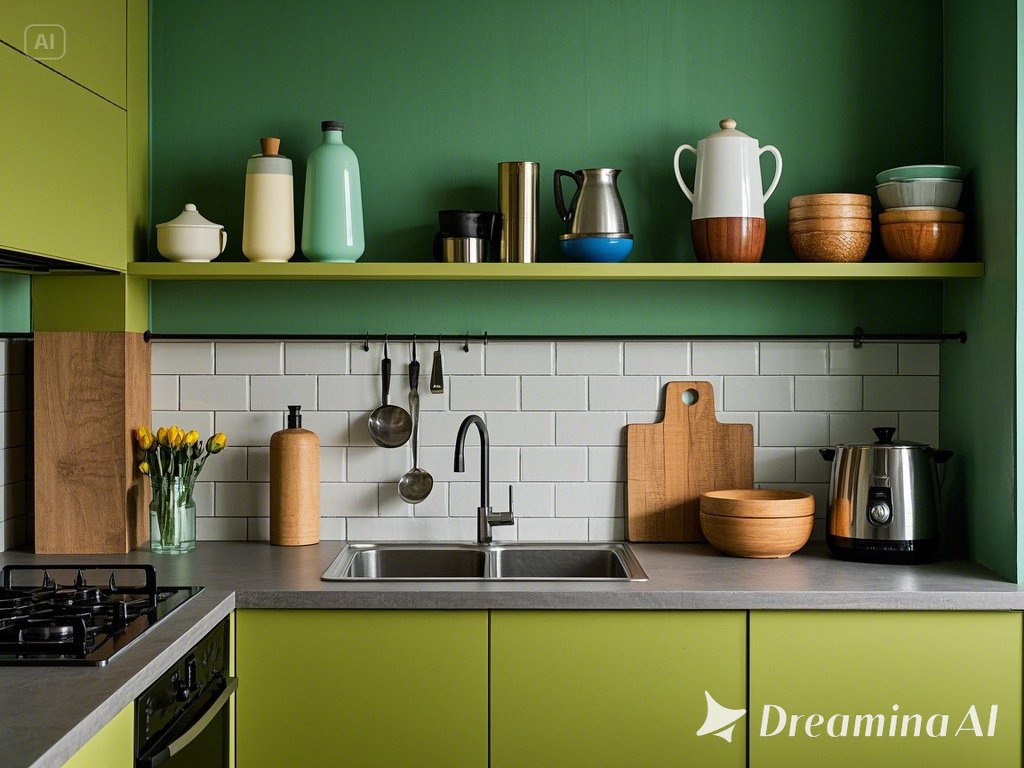
Elevate your DIY kitchen shelves from simple storage to sophisticated display features by integrating LED lighting. This adds ambiance, highlights displayed items, and provides useful task lighting. LED strips are versatile, energy-efficient, and relatively easy to install for a DIYer. They can be recessed into a channel routed into the underside of the shelf for a seamless look, or surface-mounted along the back or bottom edge. Options include warm white light for a cozy feel, cool white for a modern look, or even color-changing RGB strips for playful effects. Consider wiring them to a switch or using smart LEDs controllable via app or voice assistant. This works well with various shelf styles, from minimalist floating shelves (where the light adds to the ethereal effect) to rustic wood shelves (where it highlights texture) or glass shelves (where light refracts beautifully). Color choices for the shelves themselves can vary, but the lighting effect is often most dramatic with medium to dark shelves or when illuminating glassware or white ceramics. This trend aligns with the growing integration of smart home technology and layered lighting schemes popular in both US and European kitchen design. The DIY aspect requires basic electrical knowledge (for low-voltage systems) and careful planning for concealing wires.
Color Pop Shelves as Accent Pieces
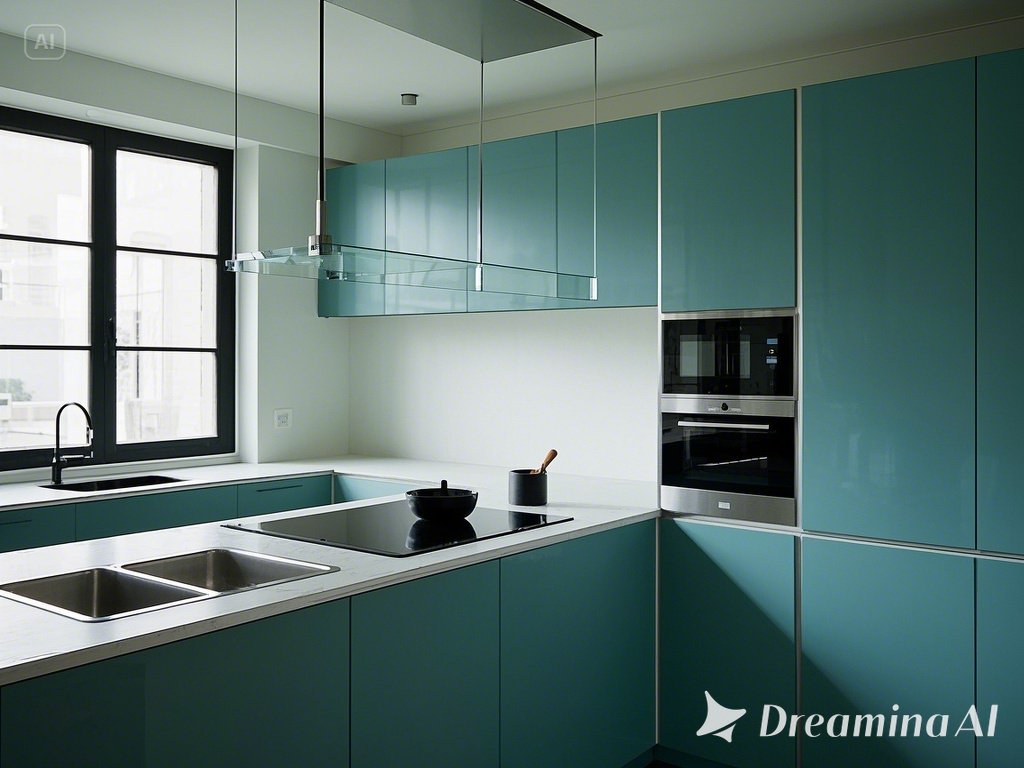
Inject personality and vibrancy into your kitchen with DIY shelves painted in a bold, unexpected color. Instead of blending in, these shelves become deliberate accent pieces, drawing the eye and adding character. Choose a color that contrasts with your walls and cabinets – think bright yellow, vibrant teal, hot pink, lime green, or a deep primary blue. The shelf style can be simple, like a basic floating shelf or a plank with simple brackets, allowing the color to be the main feature. High-gloss finishes can enhance the impact, while matte finishes offer a more contemporary feel. Use these shelves sparingly, perhaps just one or two in a strategic location, to avoid overwhelming the space. They work particularly well in otherwise neutral kitchens (white, grey, or wood-toned) where they can provide a much-needed focal point. Styling should be relatively simple to let the shelf color shine – display neutral items like white dishes or clear glassware, or carefully coordinate items in complementary colors. This approach is popular among homeowners in both the US and Europe looking to personalize their space without committing to large blocks of bold color on walls or cabinets. It’s an easy and effective DIY update – simply prime and paint existing shelves or new budget-friendly ones in your chosen high-impact hue.
Glass and Metal Elegance

For a look that speaks of lightness, modernity, and sophistication, consider DIY shelves combining glass and metal. Tempered glass shelves offer transparency, making the kitchen feel more open and allowing light to pass through – ideal for smaller spaces or areas without much natural light. The glass can be clear, frosted, or even subtly tinted (like smoked grey or bronze). Pair these glass panels with sleek metal brackets or frames. Polished chrome or stainless steel offers a crisp, modern look often seen in contemporary European designs. Brushed nickel provides a softer, more transitional feel popular in the US. Matte black metal creates a bold contrast, leaning towards industrial or modern aesthetics, while brass or gold adds a touch of Art Deco or Hollywood Glam revival. These shelves are perfect for displaying fine glassware, elegant spirits bottles, or delicate ceramics, as the transparency highlights the objects themselves. They work well against various backdrops, from tiled walls to painted surfaces. Keep the styling uncluttered to maintain the sense of airiness. While handling glass requires care, assembling these shelves using pre-cut tempered glass panels and standard metal brackets is a manageable DIY project, offering a high-end look without the bespoke price tag.
Stacked Crate Shelving for Quirky Storage
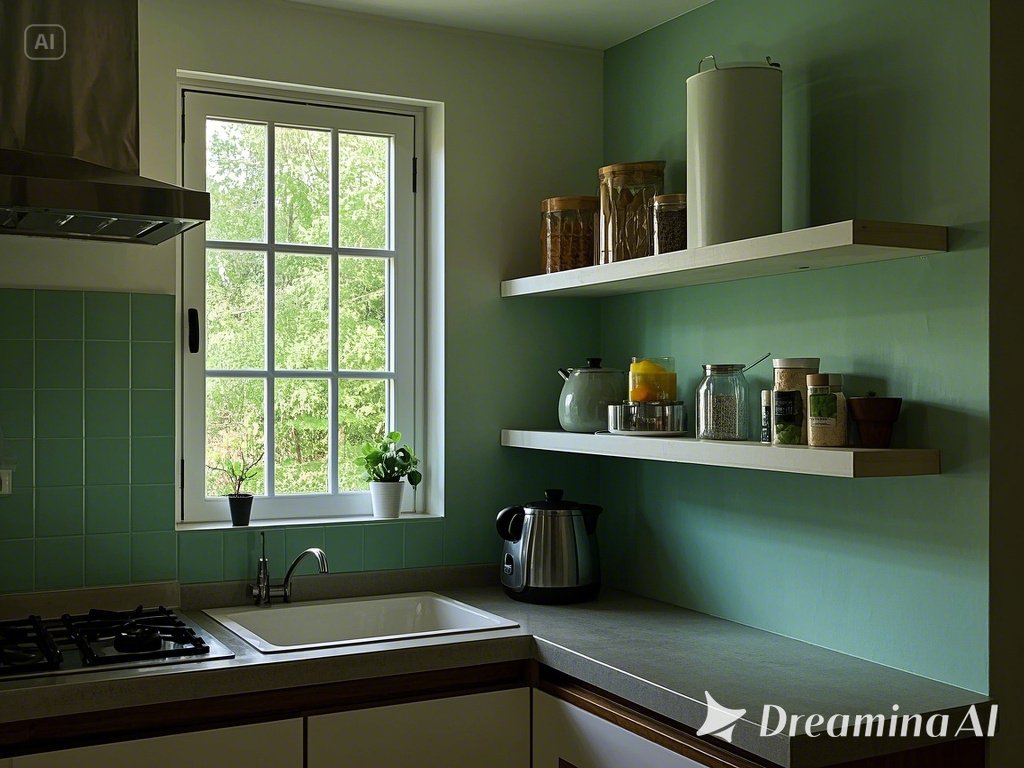
Embrace a casual, slightly rustic, or vintage vibe with DIY shelving made from stacked wooden crates. Old fruit crates, wine boxes, or newly built crate-like boxes can be arranged and secured together to form unique shelving units. They can be stacked vertically, horizontally, or in a staggered pattern on the floor, a countertop, or mounted securely to the wall. The crates can be left in their natural wood state (perhaps lightly sanded and sealed), stained, or painted. Painting them all one color (like white or grey) creates a more cohesive look, while painting individual crates different colors adds a playful, eclectic touch. Stenciling labels (“Coffee,” “Tea,” “Spices”) onto the crates enhances the vintage pantry feel. These crate shelves offer built-in compartments, perfect for organizing different categories of items – mugs in one, cookbooks in another, small jars in a third. This style fits well within farmhouse, cottage, or bohemian aesthetics and offers a budget-friendly, characterful storage solution popular for its DIY accessibility and upcycled charm in both the US and Europe. Securing the crates together and ensuring stability (especially if stacking high or wall-mounting) are the key DIY considerations.
Window Sill Extension Shelves
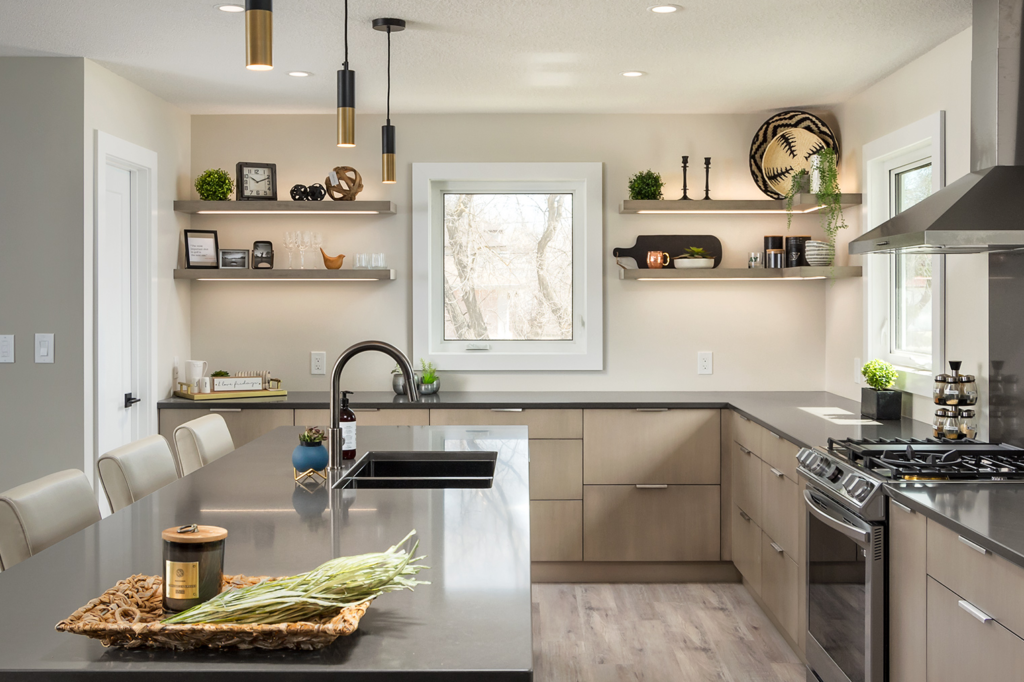
Maximize the natural light and potential of your kitchen windows by adding DIY extension shelves. This involves adding a shelf that either sits directly on the existing sill, extending its depth, or is mounted just above or below it, effectively widening the usable space around the window. This creates a perfect spot for growing herbs, displaying sun-loving plants, or showcasing decorative glassware that catches the light. The shelf material should ideally complement the window frame or surrounding trim – painted wood matching the trim is common, or a natural wood plank can add warmth. Waterproof materials like a quartz offcut or treated wood are advisable due to proximity to potential condensation or watering plants. The design should be simple to avoid obstructing the view or light too much. A narrow plank extending the sill depth or a simple floating shelf mounted level with the sill works well. Color-wise, white or light wood keeps the area feeling bright. This practical idea enhances the window area, bringing greenery and life into the kitchen, aligning with biophilic design trends popular globally. It’s a relatively simple DIY project, often involving cutting a plank to size and either resting it securely or mounting it with small brackets, instantly creating a charming and functional feature.
Ultimately, incorporating DIY shelving into your kitchen is about more than just adding storage; it’s an opportunity to infuse your space with personality, style, and improved functionality. From the rustic charm of reclaimed wood to the sleek lines of minimalist floating shelves, the possibilities are vast and adaptable to any design preference or skill level. By considering color palettes, material textures, and current trends flourishing in both the US and Europe—such as sustainability, multi-functionality, and personalized touches—you can create shelving solutions that are both beautiful and practical. Don’t be afraid to experiment and combine elements from different styles to create a look that is uniquely yours. These projects empower you to take control of your kitchen’s design, transforming it into a space that is not only efficient but also a true reflection of your taste and lifestyle.

